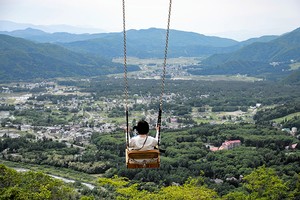THE ASAHI SHIMBUN
January 4, 2024 at 15:12 JST
In the chilly, drizzling rain, a man with an umbrella watched firefighters trying to rescue a woman trapped in the rubble from a seven-story building that had collapsed on an “izakaya” pub and residence.
The ground started to shake and a shout rang out: “Everyone, get out!”
Around 20 firefighters quickly vacated the ruins.
The aftershock had broken metal supports set up to prevent the building from falling further.
Rescue efforts had to be suspended for about 50 minutes until safety was confirmed.
The man with the umbrella muttered an expletive and wept, his shoulders shaking.
Scenes of such despair were common on Jan. 3 in areas of Ishikawa Prefecture devastated by the magnitude-7.6 earthquake that struck on New Year’s Day.
People remain trapped in the rubble, but rescue efforts have been hampered by poor weather, labor shortages, broken roads and the constant threat of aftershocks.
At the site of the collapsed building and crushed izakaya in central Wajima, one of the firefighters expressed his frustration.
“The work is progressing slowly, but we can’t rescue her right away,” he said. “We want to get her out somehow.”
Rescue operations at the precarious site are suspended each time an aftershock hits, including the one that broke the supports and registered an intensity of 5 on the Japanese seismic scale of 7.
Most of the surrounding houses have also collapsed.
A 66-year-old resident said that the man with the umbrella was shouting for help on the street on Jan. 1.
The resident tried to enter the collapsed building but stayed out because the ground kept shaking.
The man with the umbrella had always cheerfully greeted people, so it was hard to see him so disheveled, the resident said.
“I want to try to cheer him up, even if just a little,” said the resident, who gave the man a hot cup of noodles and the umbrella.
The sirens of ambulances and firetrucks blared incessantly on Jan. 3 in Wajima, while rescue dogs continued to search for people in the cold rain.
The situation in Suzu city in the prefecture was also bleak.
Etsuji Funamoto, 68, said on Jan. 3 that he still does not know what happened to his mother in her 90s and his brother in his 70s who live nearby in Suzu.
After the big quake struck on Jan. 1, he called their cellphones, but neither of them responded. Anxious, he rushed to their home.
The two-story wooden family house had collapsed, flattening the first floor. What remained of the second floor was crushed by roof tiles, and only a few windows were visible.
He called out their names, but there was no response.
Thinking they were trapped unconscious under the ruins of the building, he called 119 and 110, but the emergency lines as well as the Suzu City Hall number were busy.
After calling 119 more than 10 times, he finally reached an operator. But he was told that rescue crews were already responding to countless emergencies in the city, and that they would be unable to immediately reach his family’s home.
“I’ll put them on the list of missing people,” the operators said apologetically.
Funamoto had to hang up.
“I really wanted them to search. But it’s a tough time for everyone, so I have no choice now,” he said.
Funamoto looked for his mother and brother at evacuation centers, but they were nowhere to be found.
“I only hope that they were able to get through the debris of the collapsed house and are still alive,” he said.
Although his own home was only slightly damaged in the disaster, the road leading to his mother’s house was blocked by another collapsed house.
“I can’t wait to get them out from under the house. How much longer until the rescuers arrive?” he said.
The Suzu area on the coast was also hit by a tsunami. Soil, sand, driftwood, shoes and other debris littered the roads. Some cars were overturned and others were flooded inside.
A man in his 60s stared at the muddy living room filled with fallen leaves and tree branches on the first floor of his home.
“I’m at a total loss,” he said. “I have no choice but to tear this house down.”
(This article was written by Shun Yoshimura and Keitaro Nishizaki.)




















A peek through the music industry’s curtain at the producers who harnessed social media to help their idols go global.
A series based on diplomatic documents declassified by Japan’s Foreign Ministry
Here is a collection of first-hand accounts by “hibakusha” atomic bomb survivors.
Cooking experts, chefs and others involved in the field of food introduce their special recipes intertwined with their paths in life.
A series about Japanese-Americans and their memories of World War II